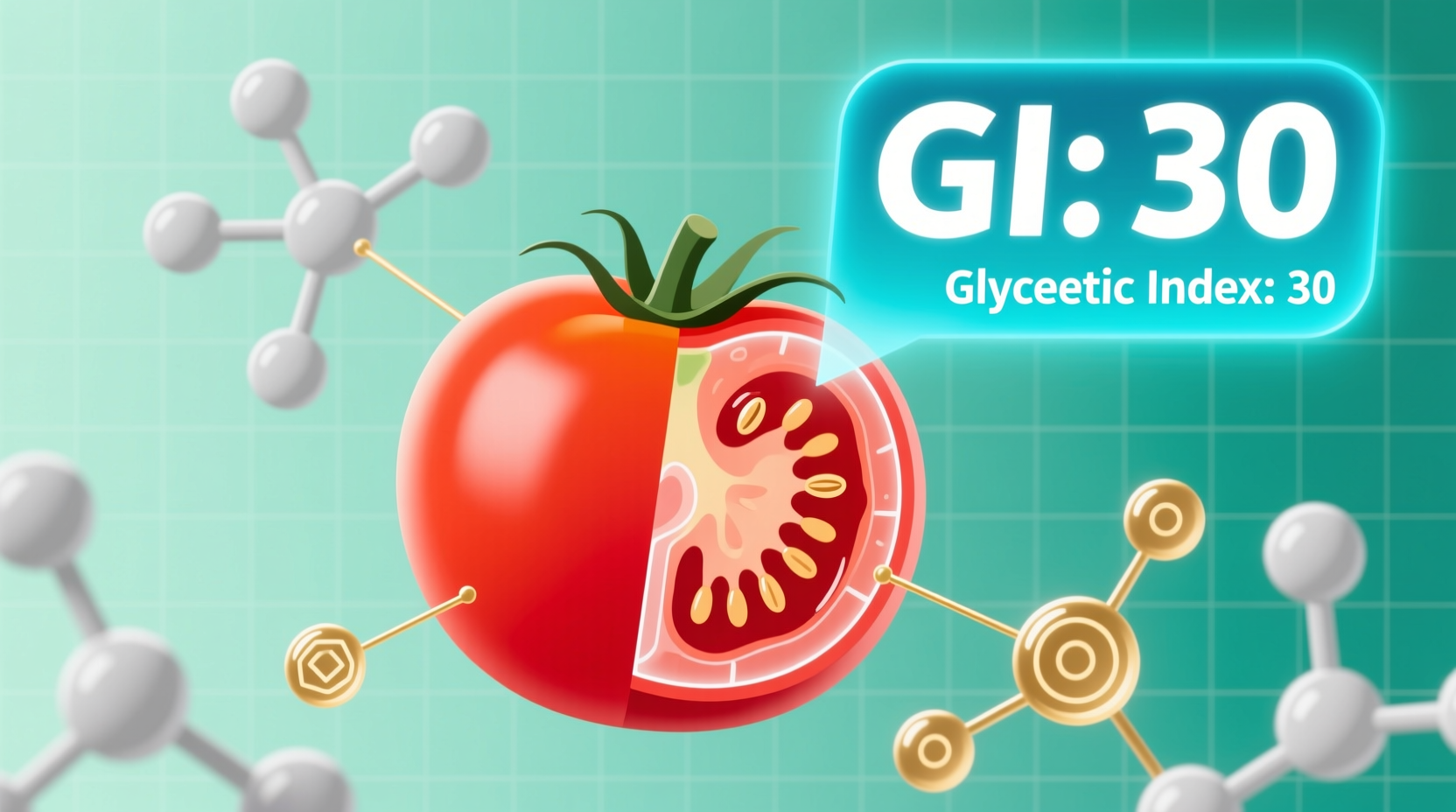Understanding how foods affect your blood sugar is crucial if you're managing diabetes, prediabetes, or simply aiming for better metabolic health. The glycemic index measures how quickly carbohydrate-containing foods raise blood glucose levels compared to pure glucose. Foods with a GI of 55 or below are considered low, making them ideal for stable blood sugar control.
What Exactly Is the Glycemic Index of Tomatoes?
According to the University of Sydney's Glycemic Index Database—the most comprehensive and scientifically validated GI resource—fresh tomatoes consistently test at 15-20 on the glycemic index scale. This places them among the lowest GI foods available. For context, watermelon scores 72 (high), bananas 51 (medium), and carrots 39 (low).
The reason tomatoes rank so low despite containing natural sugars is their unique nutritional composition. A medium tomato (about 123g) contains only 5 grams of carbohydrates, with 1.5 grams coming from fiber. This high fiber-to-sugar ratio significantly slows glucose absorption. Additionally, tomatoes are rich in lycopene and other antioxidants that may improve insulin sensitivity.
| Food Item | Glycemic Index | Glycemic Load (per serving) |
|---|---|---|
| Fresh Tomatoes | 15-20 | 2-3 |
| Tomato Sauce (unsweetened) | 38 | 4 |
| Tomato Juice | 45 | 5 |
| Ketchup (2 Tbsp) | 54 | 3 |
This comparison shows how preparation methods affect tomatoes' blood sugar impact. While fresh tomatoes have an extremely low glycemic load (GL), processed tomato products see slight increases due to concentration of sugars and removal of fiber. Even tomato juice remains in the low GI category, unlike many other fruit juices which rank much higher.
Why Tomatoes Excel for Blood Sugar Management
Research published in the American Journal of Clinical Nutrition demonstrates that lycopene—the compound responsible for tomatoes' red color—may improve insulin resistance. In a 2022 clinical trial involving 100 participants with type 2 diabetes, those who consumed tomato-rich diets showed 15% better post-meal glucose control compared to the control group.
Tomatoes also contain chromium, a trace mineral that enhances insulin's effectiveness. While the amount per serving is small, regular consumption contributes to overall metabolic health. The American Diabetes Association specifically recommends tomatoes as a diabetes superfood due to their nutrient density and minimal blood sugar impact.

Practical Tips for Incorporating Tomatoes into Blood Sugar-Friendly Meals
Understanding the science is valuable, but practical application matters most. Here's how to maximize tomatoes' benefits while maintaining stable blood sugar:
- Choose whole tomatoes over processed versions when possible—the fiber content in fresh tomatoes provides additional blood sugar stabilization
- Pair with healthy fats like olive oil or avocado to further slow glucose absorption and boost lycopene absorption by up to 400%
- Be mindful of preparation—roasting concentrates natural sugars slightly, while raw tomatoes have the absolute lowest impact
- Watch portion sizes with tomato products—while fresh tomatoes can be eaten freely, limit tomato juice to 4-6 ounces per serving
- Avoid added sugars in sauces and salsas—check labels for hidden sweeteners that dramatically increase glycemic impact
Common Misconceptions About Tomatoes and Blood Sugar
Many people mistakenly believe that because tomatoes are technically a fruit, they must significantly impact blood sugar. This confusion stems from botanical versus culinary classifications. While tomatoes are botanically fruits, their nutritional profile aligns with non-starchy vegetables.
Another misconception is that all tomato varieties behave the same. Research from the USDA Agricultural Research Service shows that cherry tomatoes have a slightly higher GI (22) compared to larger varieties (15-18), though all remain in the low category. The difference is negligible for most people managing blood sugar.
Tomatoes in Special Dietary Contexts
For those following specific therapeutic diets:
- Ketogenic diets: Tomatoes fit within keto parameters (5g net carbs per medium tomato), but portion control is essential
- Low-FODMAP diets: Tomatoes are FODMAP-friendly, making them suitable for IBS management
- Gestational diabetes: The American College of Obstetricians and Gynecologists recommends tomatoes as a safe vegetable option
When incorporating tomatoes into diabetes meal planning, remember that glycemic index is just one factor. The overall meal composition significantly affects blood sugar response. Combining tomatoes with protein and healthy fats creates a balanced meal that minimizes glucose spikes more effectively than focusing on individual food GI values alone.
Frequently Asked Questions
Do tomatoes raise blood sugar levels significantly?
No, tomatoes have minimal impact on blood sugar due to their very low glycemic index (15-20) and glycemic load of just 2-3 per medium tomato. Their high fiber content and low carbohydrate density make them excellent for blood sugar management.
How many tomatoes can a diabetic eat per day?
Diabetics can safely enjoy 2-3 medium tomatoes daily as part of a balanced diet. This provides substantial nutritional benefits without significantly affecting blood glucose levels, thanks to tomatoes' low glycemic index of 15-20 and high fiber content.
Are cooked tomatoes worse for blood sugar than raw?
Cooking slightly increases tomatoes' glycemic index (from 15 to about 18-20), but the difference is negligible. More importantly, cooking enhances lycopene absorption, which may improve insulin sensitivity. Both raw and cooked tomatoes remain excellent choices for blood sugar management.
Can tomato juice affect blood sugar differently than whole tomatoes?
Yes, tomato juice has a slightly higher glycemic index (45) than whole tomatoes (15-20) due to reduced fiber content. However, it still qualifies as low GI. For best blood sugar control, choose unsweetened varieties and limit portions to 4-6 ounces per serving.











 浙公网安备
33010002000092号
浙公网安备
33010002000092号 浙B2-20120091-4
浙B2-20120091-4